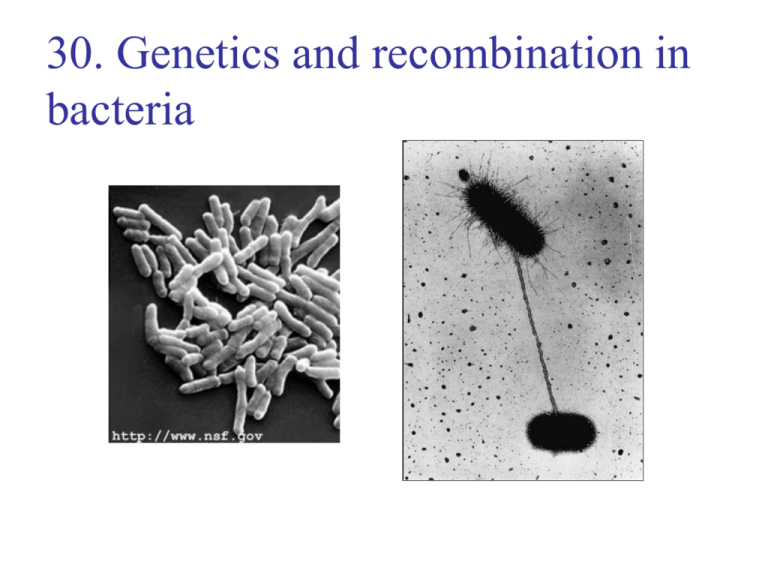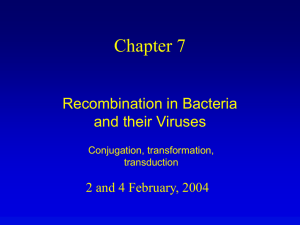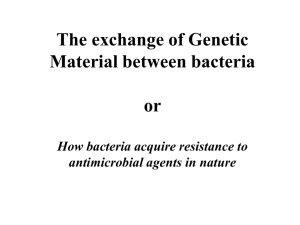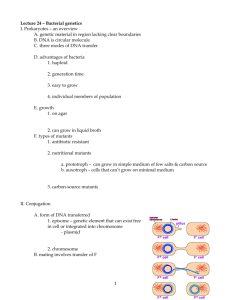Recomn in Bacteria and Viruses
advertisement

30. Genetics and recombination in bacteria Lecture Outline 11/16/05 • Replication in bacteria • Types of recombination in bacteria – Transduction by phage – Conjugation (“mating”) • F+ plasmids • Hfr strains – Transformation of raw DNA • Evidence for recombination in nature – Resistance plasmids The Bacterial Genome and Its Replication • The bacterial chromosome – Is usually a circular DNA molecule with few associated proteins • In addition to the chromosome – Many bacteria have plasmids, smaller circular DNA molecules that can replicate independently of the bacterial chromosome Genetics fo Bacteria • Use huge numbers of individuals (billions) To find very rare events • Few morphological traits – Antibiotic resistance – “Auxotrophs” cannot synthesize essential nutrients (arg- or trp-) – “Prototrophs” have normal synthesis (arg+, trp+) Replication of the circular chromosome Origin of replication Replication always starts at a certain place Replication fork Normal replication fork for DNA synthesis Termination of replication Figure 18.14 Bacterial cells usually divide asexually by binary fission but they can occasionally exchange genes: EXPERIMENT Mix two mutant strains: Arg+ Trp- and Arg- Trp+. Grown them on complete media. After a short while, test them on culture medium without Trp or Arg. Mixture Mutant strain arg+ trp– Figure 18.15 Mutant strain arg trp+ Now test them on minimal culture medium RESULTS Mixture Why do they need the control plates? Mutant strain arg+ trp– Mutant strain arg– trp+ No colonies (control) Colonies grew No colonies (control) CONCLUSION To grow on minimal medium, the cell must be able to make both Arginine and Tryptophan (Arg+, Trp+). --> Evidence for genetic transfer of one of those genes to the other strain. Four ways bacteria can exchange genes 1. Transduction Phage can transfer bacterial genes between cells 1. Phage virus infects A+B+ cell 2. Reproduction and lysis Once in a while host DNA is mistakenly packaged in a capsid 3. Transfer of a+ DNA from phage to new cell 2. Conjugation – direct transfer of genetic material between bacterial cells that are temporarily joined Donor cell contains F+ plasmid Recipient cell is F(has no plasmid) One way transfer Figure 18.17 Sex pilus 1 m Conjugation and transfer of an F plasmid from an F+ donor to an F recipient F Plasmid Bacterial chromosomes F+ cell F+ cell Mating bridge F+ cell F– cell F+ cell can form a mating bridge with an F– cell and transfer its F plasmid. Figure 18.18a Single strand of the F plasmid breaks at a specific point and moves into the recipient cell. Both cells are now F+. Donor F+ cell Synthesis of complementary strand in recipient Structure of F plasmid These genes play a role in the transfer of DNA They are thus designated tra and trb followed by a capital letter Copyright ©The McGraw-Hill Companies, Inc. Permission required for reproduction or display 3. High Frequency Recombination (Hfr cells) F factor can sometimes become integrated in to a bacterial chromosome. F+ Cell is F+ because it has all of the F factor genes MUCH more likely to transfer chromosomal genes to F- cell during conjugation Conjugation of Hfr cell with F- cell) See this in action Usually carries some chromosomal DNA along with it when it is transferred to an F– cell Conjugation and transfer of part of the bacterial chromosome from an Hfr donor to an F– recipient Hfr cell F+ cell F factor 1 Hfr cell A+ The circular F plasmid in an F + cell can be integrated into the circular chromosome by a single crossover event (dotted line). B+ C+ The resulting cell is called an Hfr cell (for High frequency of recombination). D+ C+ B+ D+ 2 D+ C+ A+ B+ A+ D+ C+ B+ B+ A+ B– A+ A+ F– cell 3 B– C– A– B+ D– Since an Hfr cell has all the F-factor genes, it can form a mating bridge with an F– cell and transfer DNA. B– Figure 18.18b A– B+ A+ Two crossovers can result in the exchange of similar (homologous) genes between the transferred chromosome fragment (brown) and the recipient cell’s chromosome (green). B– C– A– A+ D– 4 A single strand of the F factor breaks and begins to move through the bridge. DNA replication occurs in both donor and recipient cells, resulting in double-stranded DNA Temporary partial diploid 7 C– B– C– D– A– 5 The location and orientation of the F factor in the donor chromosome determine the sequence of gene transfer during conjugation. In this example, the transfer sequence for four genes is A-B-C-D. B– D– A+ B+ C– A– D– 6 C– A– D– The mating bridge usually breaks well before the entire chromosome and the rest of the F factor are transferred. Recombinant F– bacterium 8 The piece of DNA ending up outside the bacterial chromosome will eventually be degraded by the cell’s enzymes. The recipient cell now contains a new combination of genes but no F factor; it is a recombinant F – cell. Integration of F+ plasmid into a chromosome Transformation • Transformation – uptake of naked, foreign DNA from the surrounding environment • Remember Griffith’s experiment with heat killed bacteria and mice? Does this happen in nature? • In E. coli and Salmonella, roughly 17% of their genes have been acquired from other species (over 100 million years . . . ) • Such “horizontal transfer” is an important issue for the spread of antibiotic resistance Spread of Atrizine decomposing bacteria • A few bacterial species are capable of metabolizing the synthetic herbicide Atrizine • All have nearly identical genes. Atrizine catabolism plasmid Genes DEF in an operon Dispersed atrizine catabolism genes (ABC) acquired separately? Transposons flank these genes Resistance mechanisms Antibiotic Method of resistance -----------------------------------------------------------------------Chloramphenicol Tetracycline B-lactams, Erythromycin, B-lactams, Erythromycin Aminoglycosides, Chloramphenicol, B-lactams, Fusidic Acid Sulfonamides, Trimethoprim Sulfonamides, Trimethoprim Bleomycin reduced uptake into cell active efflux from the cell eliminates or reduces binding of antibiotic to target hydrolysis inactivation of antibiotic by enzymatic modification sequestering of the antibiotic by protein binding metabolic bypass of inhibited reaction overproduction of antibiotic target (titration) binding of specific immunity protein to antibiotic http://www.bioteach.ubc.ca/Biodiversity/AttackOfTheSuperbugs/









